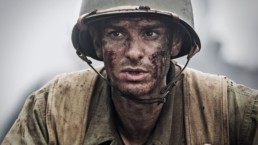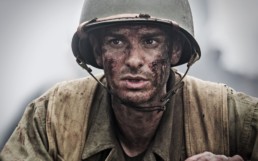‘Hacksaw Ridge’ Review: In Beautiful Yet Brutal a Pacifist Goes to War
Gibson's depiction of this hell-on-Earth is more persuasive sermonizing than any petty, politicized paranoia drama.
Before the first bullets are even fired, it seems like we’ve already seen enough. And once they fly, Hacksaw Ridge unleashes a vision of war worthy of comparison to Saving Private Ryan or Come and See.
When it came out in 2004, The Passion of the Christ instantaneously became one of the most surreal pop culture events of the 21st century. An antagonistic, foreign-language psychological drama from an independent studio became the film everyone was talking about and, eventually, the biggest R-rated film of all time – a title it retains here in the States. The film’s noteworthy intersection of deism and masochism, it turns out, was the ultimate motif of Mel Gibson as a director.
His previous effort, Apocalypto, has to be the most esoteric, daring, and perverse film ever distributed by Buena Vista – and also one of his signature unhinged historical epics. A decade later, however, the prospect of a new film from the Mind of Mel doesn’t exactly inspire nostalgia. Being one of the definitive figures of Bush-era zeitgeist is one thing; another matter entirely was his public fall from grace, which needs no recap here. Regardless, the original Mad Max himself finds his way back to the director’s chair with Hacksaw Ridge, and in doing so reunites with screenwriter Randal Wallace and the thematic territory of martyrdom.
The film recounts the story of Desmond T. Doss, an American medic during the Battle of Okinawa who was known for refusing to bear arms – even in the heat of battle – which lead to his status as the first conscientious objector to receive the Medal of Honor. Doss’s peculiar case of pacifism and Seventh Day Adventism made him an unlikely hero of World War 2, but his perspective provides a unique framework for the blood-soaked Gibsonian aesthetic.
If it weren’t for the in medias res opening shots, the first half hour of mildly clichéd Greatest Generation melodrama might imply a subdued rehabilitation for the notorious character behind the camera. There are some highlights to this stage of the film, especially with Andrew Garfield’s Doss as such a hearty presence. The supporting cast includes Vince Vaughn in an admirable R. Lee Ermey homage, and a couple of Gibson’s fellow Australians: a tragic turn by Hugo Weaving as elder Doss, and Sam Worthington, for whom Army Captain is a natural fit.
Halfway through, it’s clear Gibson has in fact retained his appetite for destruction through his exile. The initial foray into the Pacific Theater echoes the way his camera slowly marched into the belly of the Mayan empire in Apocalypto. The anxiety begins with the foreboding image of cadavers and the thousand-yard stare in a retreated soldier, yet Gibson masterfully winds us up even more upon Doss’s battalion entering the battlefield. Before the first bullets are even fired, it seems like we’ve already seen enough. And once they fly, Hacksaw Ridge unleashes a vision of war worthy of comparison to Saving Private Ryan or Come and See.
If anything, Gibson’s depiction of this hell-on-Earth is more persuasive sermonizing than any petty, politicized paranoia demonstrated by the likes of God’s Not Dead. Yes, this is ultimately a film about and conceived by a sense of religious conviction, yet it is not designed with exclusivity as The Passion was. The juxtaposition of the most violent film in recent memory with its nonviolent hero prompts challenging questions about the authority and compromise of morals, regardless of worldview.
There are misjudged moments that may serve to reinforce Gibson’s reputation. The one that comes to mind is an obligatory montage of the enemy’s surrender towards the end that is filmed in a questionable manner as the Japanese military go down in a blaze of gratuitous self-immolation. It is not without these moments of the tacky and the trite, but Hacksaw Ridge is an effective war drama and reintroduction to its helmer’s lyrical brutality. There remains significant doubt that a sequel to Passion is what the world needs.
“Hacksaw Ridge” is rated R for intense prolonged realistically graphic sequences of war violence including grisly bloody images. 2 hours 11 minutes. Now playing in select cities.
Jared Anderson
Jared was always a bit of a math nerd in school, but a fan of film critic personas like Roger Ebert and Mark Kermode. He currently resides in College Station, TX and has started Graduate School at Texas A&M (M.S. Statistics) while continuing to write on films that expand to nearby theaters.


